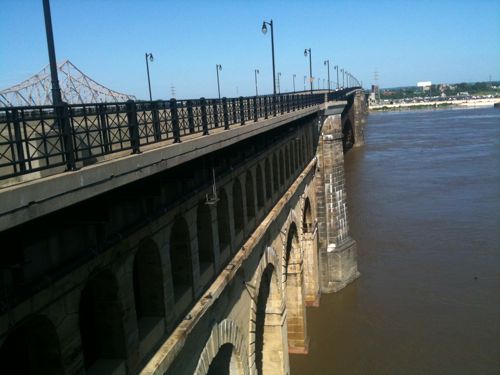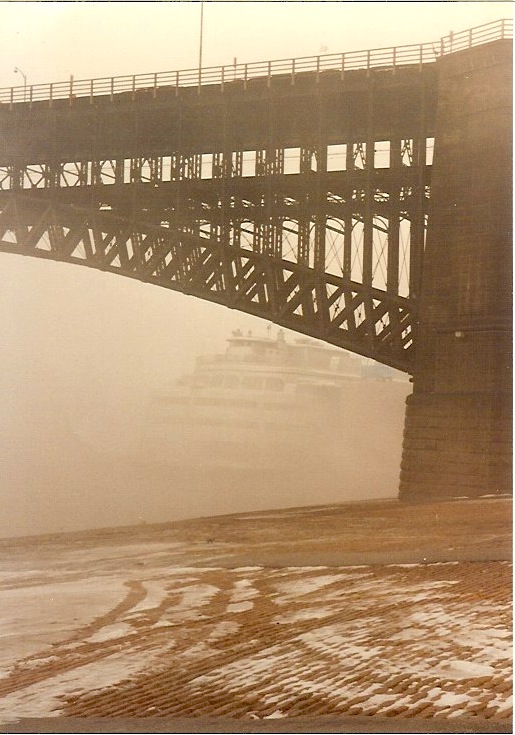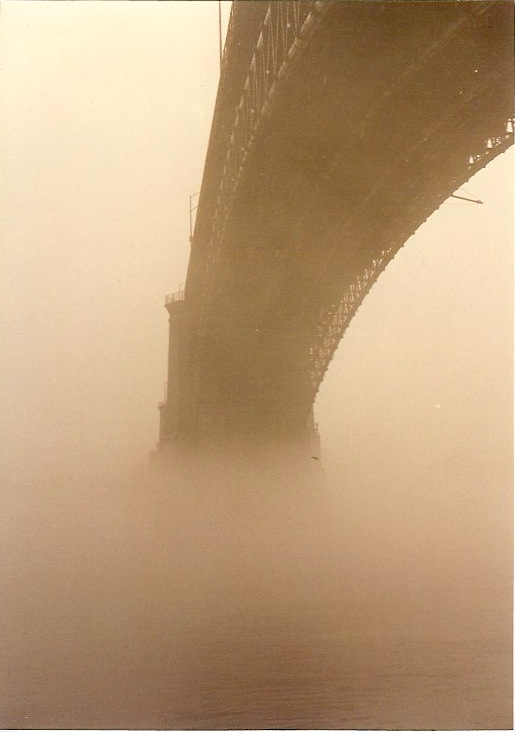Happy 137th Birthday to the Eads Bridge

When I moved to St. Louis, almost 21 years ago, I immediately fell in love with Eads Bridge. The rail lines on the lower level of the bridge hadn’t been used in 15 or so years. The road deck was in place but it was removed during construction of the  MetroLink light rail that opened in 1993. The bridge was so beautiful to my young eyes.


The history of the bridge is fascinating. Â It opened 137 years ago today on June 4, 1874 with the official dedication was a month later on July 4, 1874:
The bridge is named for its designer and builder, James B. Eads. When completed in 1874, the Eads Bridge was the longest arch bridge in the world, with an overall length of 6,442 feet (1,964 m). The ribbed steel arch spans were considered daring, as was the use of steel as a primary structural material: it was the first such use of true steel in a major bridge project.
The Eads Bridge was also the first bridge to be built using cantilever support methods exclusively, and one of the first to make use of pneumatic caissons. The Eads Bridge caissons, still among the deepest ever sunk, were responsible for one of the first major outbreaks of “caisson disease” (also known as “the bends” or decompression sickness). Fifteen workers died, two other workers were permanently disabled, and 77 were severely afflicted.
On 14 June 1874, John Robinson led a “test elephant” on a stroll across the new Eads Bridge to prove it was safe. A big crowd cheered as the elephant from a traveling circus lumbered towards Illinois. It was believed that elephants had instincts that would keep them from setting foot on unsafe structures. Two weeks later, Eads sent 14 locomotives back and forth across the bridge at one time.
The Eads Bridge, which became an iconic image of the city of St. Louis, from the time of its erection until 1965 when the Gateway Arch was constructed, is still in use. The bridge crosses the St. Louis riverfront between Laclede’s Landing, to the north, and the grounds of the Gateway Arch, to the south. Today the road deck has been restored, allowing vehicular and pedestrian traffic to cross the river. The St. Louis MetroLink light rail line has used the rail deck since 1993. (Wikipedia)
This bridge, and the railroad tunnels under downtown, allowed the first Union Station to open a year later on June 1, 1875. Â This Union Station was located at 12th (now Tucker) & Poplar. The Union Station we know opened 6 blocks to the west just 19 years later on September 1, 1894.
In 2024 we need to have a big party to celebrate the 150th anniversary of Eads Bridge. Â Hopefully by then the raised section of I-70 at the west end of the bridge will be gone, opening sight lines.
– Steve Patterson
What’s interesting is that it gives so much/equal space for a roadway. Most other bridges of that vintage were primarily railroad bridges, with a single traffic lane hung off either side for vehicles, like the MacKinley Bridge, downriver. It wasn’t until the 1920’s that solely-vehicular bridges started being built, like the old Chain of Rocks Bridge. It’s also interesting, but good, that tunnels were chosen to get trains from the riverfront through downtown. Other cities used surface or elevated tracks. This infrastructure investment “back in the day” paid HUGE dividends when Metrolink was constructed decades later.
What’s interesting is that it gives so much/equal space for a roadway. Most other bridges of that vintage were primarily railroad bridges, with a single traffic lane hung off either side for vehicles, like the MacKinley Bridge, downriver. It wasn’t until the 1920’s that solely-vehicular bridges started being built, like the old Chain of Rocks Bridge. It’s also interesting, but good, that tunnels were chosen to get trains from the riverfront through downtown. Other cities used surface or elevated tracks. This infrastructure investment “back in the day” paid HUGE dividends when Metrolink was constructed decades later.
What’s interesting is that it gives so much/equal space for a roadway. Most other bridges of that vintage were primarily railroad bridges, with a single traffic lane hung off either side for vehicles, like the MacKinley Bridge, downriver. It wasn’t until the 1920’s that solely-vehicular bridges started being built, like the old Chain of Rocks Bridge. It’s also interesting, but good, that tunnels were chosen to get trains from the riverfront through downtown. Other cities used surface or elevated tracks. This infrastructure investment “back in the day” paid HUGE dividends when Metrolink was constructed decades later.
The McKinley bridge is upriver and it had the outside lanes for decades, it was the original bridge for Route 66. When rail traffic ceased in 1978 the center was surfaced for vehicles to use in addition to the original outside lanes.
The MacArthur bridge downriver was also designed to carry vehicular and rail traffic, although vehicles haven’t crossed in decades.
MacArthur bridge was scary to drive across. There was a very tight jog or left-right ess-curve located at just about directly over the east side shoreline and not everybody drove it at a safe speed.
I remember too, sometime in the fall of 1964 several carloads undergrads from Parks College in Cahokia were heading over to SLU for some kind of dance evening and we all “ran” the bridge toll booth. The poor guy was waving and flailing as 8 or so cars zoomed on thru. The toll booth was located on the St Louis side way down the ramp almost to ground level.
I was riding in the passenger seat of an Austin Healey Sprite (only a 2-seater) and a well-overweight fellow student was riding the center by sitting up on the turtle deck with his feet on the transmission tunnel between the driver and I. We were something like car number five or six in the line of toll-runners, maybe going 15-20 MPH, and just before going past the by-then-screaming toll guy the big-butt guy on the turtledeck dropped his pants and gave the poor toll taker a full-blown moon.
Thanks Steve for jogging the fun memory of that one.
alf
The McKinley bridge is upriver and it had the outside lanes for decades, it was the original bridge for Route 66. When rail traffic ceased in 1978 the center was surfaced for vehicles to use in addition to the original outside lanes.
The MacArthur bridge downriver was also designed to carry vehicular and rail traffic, although vehicles haven’t crossed in decades.
The Eads is STL’s Eiffel Tower, I can think of no better comparison. No less a feat of daring engineering and risky investment, and 25 years older as well. It’s mind blowing what an ambitious city Saint Louis was at one time.
The Eads is STL’s Eiffel Tower, I can think of no better comparison. No less a feat of daring engineering and risky investment, and 25 years older as well. It’s mind blowing what an ambitious city Saint Louis was at one time.
One of my favorite bridges on the whole planet. Probably on of the most beautiful, as well. Simple, elegant, a marvel of engineering and materials science, a groundbreaking method of digging the massive support piers on the riverbed–albeit sadly resulting in the deaths of fifteen men, all during the construction of the first pier, on the east side of the river. The construction of the west pier, after adjustments made by Eads and consulting physician, resulted in the death of only one man. Great story and a great bridge. http://www.nps.gov/jeff/historyculture/upload/eads.pdf, and this, about the contributions of Colonel Henry Flad (as in Flad Avenue):http://stlcin.missouri.org/history/structdetail.cfm?Master_ID=1324. Truly, one of the great stories of the late nineteenth century.
One of my favorite bridges on the whole planet. Probably on of the most beautiful, as well. Simple, elegant, a marvel of engineering and materials science, a groundbreaking method of digging the massive support piers on the riverbed–albeit sadly resulting in the deaths of fifteen men, all during the construction of the first pier, on the east side of the river. The construction of the west pier, after adjustments made by Eads and consulting physician, resulted in the death of only one man. Great story and a great bridge. http://www.nps.gov/jeff/historyculture/upload/eads.pdf, and this, about the contributions of Colonel Henry Flad (as in Flad Avenue):http://stlcin.missouri.org/history/structdetail.cfm?Master_ID=1324. Truly, one of the great stories of the late nineteenth century.
This may be folklore, but a local planner told me that all 14 locomotives were hitched together as a train. One of the engineers in the middle got cold feet and threw on the breaks just as the train was approaching the Eads Bridge for the test run. No matter the locomotive was dragged across the bridge by the other 13 wheels locked up.
The Eads Bridge cost about $6 million as I recall, about twice the projection. I am not endorsing cost over runs, but the return on investment to the region has been huge despite the added cost at the time
This may be folklore, but a local planner told me that all 14 locomotives were hitched together as a train. One of the engineers in the middle got cold feet and threw on the breaks just as the train was approaching the Eads Bridge for the test run. No matter the locomotive was dragged across the bridge by the other 13 wheels locked up.
The Eads Bridge cost about $6 million as I recall, about twice the projection. I am not endorsing cost over runs, but the return on investment to the region has been huge despite the added cost at the time
I think the little plazas that are formed by each column into the river originally had statues, I can’t remember where I saw that or if it is correct. If they were there, they apparently didn’t last long.
I think the little plazas that are formed by each column into the river originally had statues, I can’t remember where I saw that or if it is correct. If they were there, they apparently didn’t last long.
I stand corrected – thanks!
I stand corrected – thanks!
MacArthur bridge was scary to drive across. There was a very tight jog or left-right ess-curve located at just about directly over the east side shoreline and not everybody drove it at a safe speed.
I remember too, sometime in the fall of 1964 several carloads undergrads from Parks College in Cahokia were heading over to SLU for some kind of dance evening and we all “ran” the bridge toll booth. The poor guy was waving and flailing as 8 or so cars zoomed on thru. The toll booth was located on the St Louis side way down the ramp almost to ground level.
I was riding in the passenger seat of an Austin Healey Sprite (only a 2-seater) and a well-overweight fellow student was riding the center by sitting up on the turtle deck with his feet on the transmission tunnel between the driver and I. We were something like car number five or six in the line of toll-runners, maybe going 15-20 MPH, and just before going past the by-then-screaming toll guy the big-butt guy on the turtledeck dropped his pants and gave the poor toll taker a full-blown moon.
Thanks Steve for jogging the fun memory of that one.
alf
Any thoughts on the Arch Design on how it eliminates the side street along Eads and thus the entire focus of Wash U/Eads Bridge is to get you across and back the Big Muddy?Â
Any thoughts on the Arch Design on how it eliminates the side street along Eads and thus the entire focus of Wash U/Eads Bridge is to get you across and back the Big Muddy?